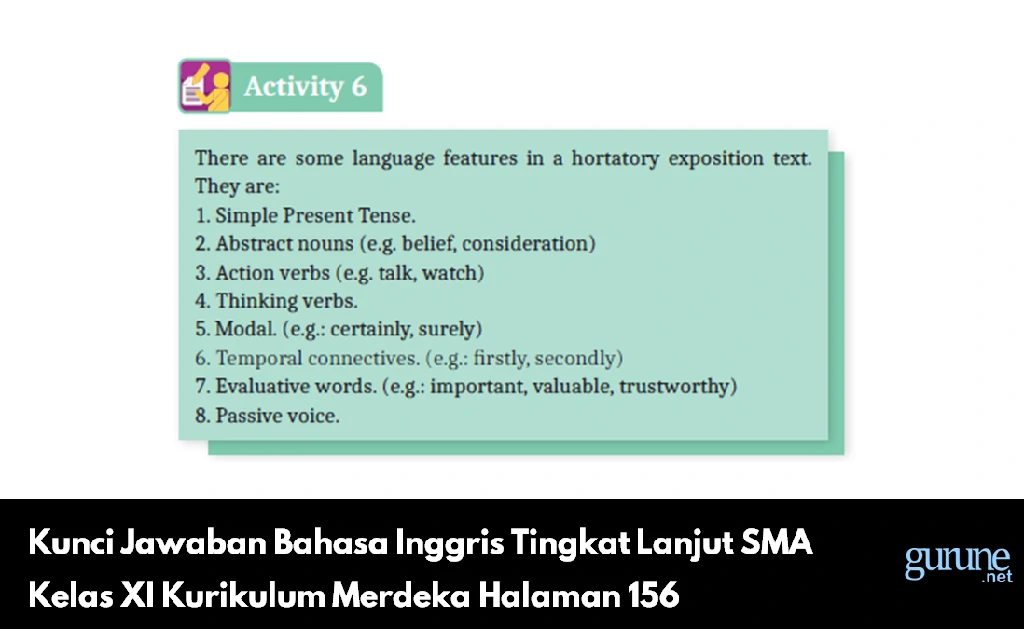Kunci Jawaban Bahasa Inggris Tingkat Lanjut SMA Kelas XI Kurikulum Merdeka Halaman 156– Halo sobat gurune, salah satu cara efektif untuk memperdalam pemahaman bahasa Inggris adalah melalui pengerjaan soal-soal yang memerlukan pemahaman mendalam tentang teks, termasuk teks eksposisi hortatori.
Kali ini kita akan membahas soal tentang menjelaskan fitur bahasa dan fungsi dalam teks eksposisi hortatori. Pembahasan soal ini terdapat pada buku Bahasa Inggris Tingkat Lanjut untuk SMA Kelas XI Kurikulum Merdeka. Berikut adalah pembahasan soal selengkapnya !
Kunci Jawaban Bahasa Inggris Tingkat Lanjut SMA Kelas XI Kurikulum Merdeka Halaman 156 – Activity 6
Activity 6
| There are some language features in a hortatory exposition text.
They are: 1. Simple Present Tense. 2. Abstract nouns (e.g. belief, consideration) 3. Action verbs (e.g. talk, watch) 4. Thinking verbs. 5. Modal. (e.g.: certainly, surely) 6. Temporal connectives. (e.g.: firstly, secondly) 7. Evaluative words. (e.g.: important, valuable, trustworthy) 8. Passive voice. |
Baca Juga : Kunci Jawaban Pengimajian/Citraan dalam Puisi
Take a closer look at the text entitled “Students Should be Allowed to Use Mobile Technologies in Class” again. You will find the language features in the text.
| Students should be allowed to use mobile technologies in class |
| For hundreds of years, education has been closely connected to writing. Professors had been writing down their lectures, and students had been keeping notes after their teachers. Goose feathers and parchment changed to ballpoint pens and paper. With the emergence and development of mobile technologies, students nowadays tend to use smartphones or laptops in class more often than pens and paper. There are many arguments in favour of doing so. |
| First of all, let us face reality: people do not write as much today as they used to several years ago. This is especially true in the case of the youth: teenagers and young adults tend to feel more confident and comfortable typing on their devices rather than with handwriting. Keeping records after a teacher in class requires a student to write extremely fast, which often decreases the readability of the notes taken. Sometimes it can be extremely difficult for a student to understand what he or she hurriedly wrote down in class. At the same time, typing on a smartphone or laptop helps write the important information down in a comprehensible and accurate way. Also, handwriting always involves grammatical mistakes, typos, blots, and so on. |
| Secondly, technology is something youth nowadays have got so accustomed to that without it, they operate less efficiently. Students are native to such devices as smartphones, laptops, tablets, and other gadgets, and naturally incorporate them in whatever they do, be it leisure time or studying. Not allowing students to use smartphone or tablet in class means to deprive them of something that is almost a part of them and of their daily lives. If young people know how to use technology to their advantage and increase their studying effectiveness with its help, why forbid them from doing it? |
| Thirdly, the use of mobile technologies helps make the studying process more engaging for students. For example, there are teacherswho like to illustrate their lectures with photographs, charts, or interactive graphics. If students are using smartphone or laptop, a teacher can send them supplementary educational materials via email or in social media. Or, students may be able to look up contradictory and/or insufficient information during the course or a lecture, and ask questions immediately. Smartphone and laptop also allow changing the format of teaching. Some teachers develop experimental ways of lecturing, and these new methods tend to show promising results. Needless to say such formats of studying are more appealing to young people who value their freedom and time, and prove to be extremely effective. |
| Based on the arguments above, allowing students to use smartphone and laptop in class would be a small but substantial change. Modern students are digital natives, and can effectively use technologies to their advantage. They would be able to not just take notes on lectures more effectively, but would also eagerly engage in new forms of studying such as remote studying, using interactive online materials, and so on. |
Baca Juga : Kunci Jawaban Menemukan Penggunaan Majas Dalam Puisi
Pay attention to the word in bold and explain their language features and functions in a hortatory exposition text.
| No | Words/phrases | Explanation |
| 1 | For hundreds of years, | |
| 2 | First of all, | |
| 3 | Secondly, | |
| 4 | Less efficiently | |
| 5 | Write | |
| 6 | Helps | |
| 7 | Substantial |
Jawaban :
| No | Words/phrases | Explanation |
| 1 | For hundreds of years, | connectives |
| 2 | First of all, | connectives |
| 3 | Secondly, | connectives |
| 4 | Less efficiently | modal adverb |
| 5 | Write | action verbs |
| 6 | Helps | action verbs |
| 7 | Substantial | evaluative words |
Kesimpulan
Demikianlah informasi yang dapat disajikan. Dengan demikian, melalui pemecahan soal yang memerhatikan kata-kata dalam teks eksposisi hortatori, pembelajaran bahasa Inggris dapat menjadi lebih menarik dan bermakna. Semoga dengan pembahasan soal di atas dapat mempermudah sobat dalam belajar.
Baca Juga : Kunci Jawaban Makna Kata Konkret pada Puisi
Disclaimer :
1. Jawaban dan pembahasan pada postingan ini mungkin akan berbeda dengan jawaban sumber lain.
2. Jadikan postingan ini sebagai salah satu bahan referensi dalam menjawab soal bukan sebagai acuan utama dan satu-satunya.
3. Postingan ini tidak mutlak kebenarannya.
